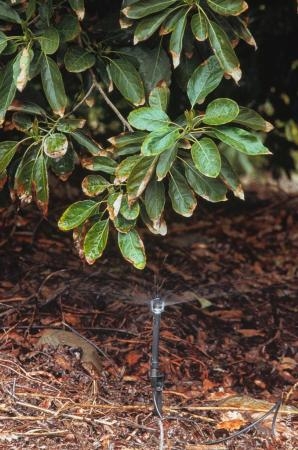- Author: Ben Faber
Avocado Trunk Cankers
This has been a low rainfall year, and often with the low rainfall, cankers will seem to suddenly appear on the woody parts of the tree. There are a number of causes for the white exudate from cankers on the trunk and limbs of avocado. Any wound will cause the tree sap to run and crystalize on the surface. It is a seven carbon sugar of mannoheptulose, or its alcohol form perseitol. It's sweet. So any wound that might be caused by woodpeckers or little kids climbing the trees will damage the bark, and where the damage has occurred, the sugar will form. There are also diseases that can cause a wound that will exude the sugar. Three of these are due to water stress of some form that allows infection to occur. One of these is bacterial – Bacterial Canker. Another is caused by a fungus which in the past was called Dothiorella Canker. We now know it by a different name and a UCR plant pathologist has actually identified seven different species of fungus that invade the wood and can eventually weaken the tree so limbs can break and the tree becomes unthrifty. In the case of very young trees, they can be killed by the fungus. A third cause of sugary cankers is Black Streak, the cause of which was unclear until recently when Dr. Akif Eskalen possibly identified it. It was coming from a similar set of fungi that cause Dothiorella Canker. It makes sense, because in all three of these cases, they most often appear after a low rainfall year, where pressures in irrigation systems are insufficient, where emitters have clogged and where water or salinity stress have occurred. The bacteria and fungi that cause these cankers are widely distributed in most orchards and are just waiting for the stressed tree to appear. The grower just needs to identify where this stress is occurring, correct the problem (clogging, low pressure, poor irrigation design, infrequent scheduling, inadequate leaching, etc.) and if the damage is not too extensive, often these symptoms will disappear with time.
The fourth cause of canker is caused by Phytophthora citricola, a relative of avocado root rot. This is caused by a moist trunk, either from irrigation water hitting the trunk, or on the north side of the tree that doesn't dry out from morning dew. This is a much slower acting disease than root rot, although it can rapidly kill young trees. The cankers occur at about 18 inches from the ground and gradually girdle the tree. The first thing to do before ever seeing this disease is to make sure irrigation water isn't hitting the trunks. If cankers appear, they respond to the same materials used for root rot, but should actually be sprayed right on the canker.
Images
Top: Black Streak can occur on trunks or branches as small, scattered cankers. The name comes from the blackening that occurs around the infected area.
Next: Bacterial Canker causing discrete silver dollar-sized cankers. The exudate running down from the bottom edge results when a knife is poked into it. The cankers tend to run in a line up the trunk or branch.
Next: Citricola crown rot with the cankers girdling the trunk. It appears near the ground.
Bottom: Dothiorella Canker (soon to have a new name) can occur anywhere on the trunk or branches
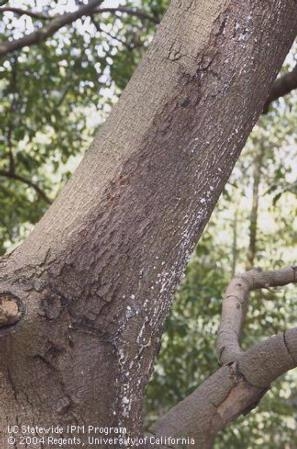
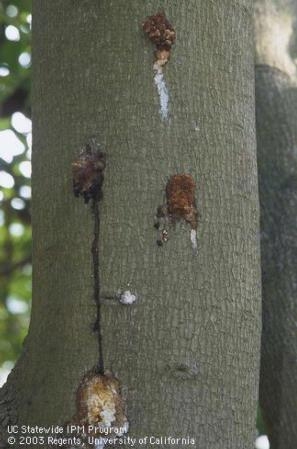
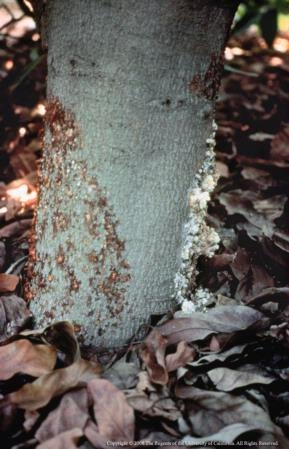
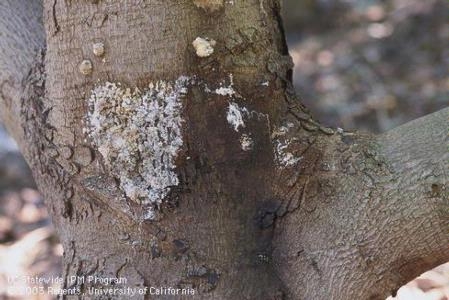
- Author: Ben A Faber
Each year the California Avocado Commission partners with Land IQ to produce a Statewide Avocado Acreage and Condition Analysis report utilizing digital satellite imagery, aerial photography and analytical tools to survey California avocado groves. This data helps the Commission make informed budgeting and marketing decisions and provides industry members with spatial data concerning crop type, location, condition and density. See the full 2023 Report HERE.
According to the report:
- In 2023 there were 52,534 planted avocado acres
- The majority of growing acreage is located in Ventura, San Diego, Santa Barbara, Riverside and San Luis Obispo Counties with a total of 50,818 planted acres
- The five top-producing counties reported 1,059 new/young acres and 3,399 topped/stumped acres
The report also provides acreage data by zip code, county, condition, year planted and density.
The California Avocado Commission's crop estimating team in conjunction with Land IQ uses the latest in remote sensing techniques to assess avocado acreage in production. As technology continues to advance refinements in our fourth generation of remote sensing techniques were applied to satellite imagery collected during spring and summer months. The imagery processing techniques include; segmentation into homogenous polygons, retention of tree crop polygons, calculation of average crop canopy moisture and vegetation indices, analysis of change maps from previous inventories, and classification of avocado groves into four categories; producing, topped/stumped, new/young, and abandoned. Aerial imagery (for a real-world view), and satellite imagery (for spectral and temporal data) are integrated into previously classified avocado acreage and analyzed for current condition of California avocado acreage statewide.
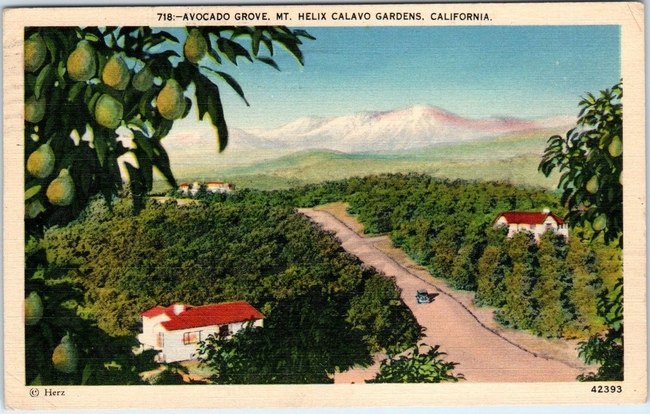
- Author: Ben A Faber
Farm Advisor UCCE Ventura County
Plants, therefore avocados, go through different growth stages, so called phenological stages, regular periods where they grow and differentiate from seed to various vegetative stages, flowering and finally seed production. Avocado has a preset pattern of phenology that occurs depending on variety and where it is grown, driven by light, temperature, water availability and often by different stresses, such as cold, heat, and heavy or light crop load.
The successive stages of avocado phenology are demonstrated in the photomontage below, from bud break to harvestable fruit:
Main phenological growth stages of ‘Hass' avocado according to the extended BBCH scale. From: http://avocadosource.com/journals/elsevier/scientiahort_2013_164_434-439.pdf
And, depending on where in California the avocado is growing, the latitude, or on what side of the slope (in the shade or full sun, on the top of the slope, etc.), the tree will go through these successive stages at different times of the year, offset by weeks or even months. A general plan for the California coastal region was developed from accumulated experiences and tests by a variety of groups and is shown below:
Research-based information that allows producers to anticipate the regionally appropriate times for major phenological evets is limited in California. From work conducted at South Coast Research and Extension Center in Irvine, the onset of flowering in early March extends into May, normally, and the main fruit set period is between mid-April and May. In later work from the same location, a mean beginning bloom date for “on” and “off” crop years differed between Julian date 66 (March 7) and 80 (March 21), respectively. From avocado research in Carpinteria, flower abscission (as a measure of bloom) during “on” and “off' crop years peaked on two different Julian dates, (May 4 and June 2). Mid-June has been reported as the middle of the commercial ‘Hass” season for the Irvine area. Harvest in Santa Barbara and San Luis Obispo Countries may just be staring in mid-June and continue through November in the most northern growing areas.
Difference in crop development impact the timing of cultural practices, such as fertilization, irrigation, phytophthora treatment, pollination and gibberellin sprays. For instance, nitrogen fertilization is often recommended by month of the year, rather than growth stage of the tree. Several recent efforts indicated that the timing of nitrogen fertilizer may have significant impacts on yield and that two times the fertilizer rates in April and November may result in substantial yield increase. Available information indicates the April timing might correspond to fruit set for the Irvine area compared to early bloom for Santa Barbara and San Luis. By November, Irvine's current year's crop may have been harvested three months previously. In San Luis Obispo, harvest may have just ended. So just going by date is insufficient for guiding many horticultural activities.
California's trees often have two crops maturing at the same time. It becomes especially pronounced the further north the production. The management of multiple crops on each tree becomes more important and more confusing as the length of time the fruit remains on the tree. Carrying two and even three loads of crop increases the potential for alternate bearing. Reduction in alternate bearing has been determined to be an important strategic requirement for California's growers. Understanding the impacts of cultural practices on alternate bearing is important. For example, the chart below demonstrates a stylized calendar of the avocado growth cycle for California. Rate and application timing of nitrogen as predicted by the Avocado Nitrogen Model proposed by Rosecrance et al. (2013 and Calculator) are noted for a 15,000 per acre yield outcome. The “on” year suggests nitrogen rate for the late fruit growth/harvest/summer and fall flush period is 15 lbs. This application coincides with the fruit set timing for 16 lbs of N for the “off” bloom crop during the later bloom/fruit set/spring shoot growth phase. Rates and timings to support these crops ought then be combined and represent the 2X fertilizer rate that Lovatt (2001) found to have significant effects on yields.
Calendar of avocado growth cycles with both “on” and “off” years represented when they overlap, and suggested nitrogen fertilization timings and amounts.
Taking into account the actual phenology, what is happening in your trees, then is important for assessing when to make N applications. In the winter and spring of 2023, it seems like everything was on a different cycle. Thrips delayed their appearance, flowering was erratic. Honeybees seemed to have found somewhere else to hang out, because they were not flying in the avocado trees. And then suddenly, we had some fruit set in Ventura in late June. This is a really clear example of the problem of following a cookbook to farming avocados. The point here is that just going by the calendar is not going to meet the needs of the tree. The phenological stages of the tree in your environment needs to be taken into consideration.
Notes:
Lovatt, C.J. 2001 Properly Timed Soilapplied Nitrogen Fertilizer Increases Yield and Fruit Size of ‘Hass' Avocado. J. Amer. Soc. Hort. Sci. 126(5): 555?559.
Rosecrance, R., Lovatt, C.J., 2013. Management tools for fertilization of the 'Hass' avocado. FREP final report.
Calculator: https://rrosecrance.yourweb.csuchico.edu/Model/AvoModel/Avo2NKModel.html
- Author: Ben Faber
California Avocado Growers Seminars Series 2024
Scheduled Topics
February 15 (10 - 12 AM)
HOW TO MANAGE THE TREES IN A WET YEAR
Topics and Speakers
By Hamutahl Cohen, PH.D. Entomology Advisor, UC Cooperative Extension
PCA Panel on Thrips Management Under Different Weather Scenarios
Moderator Dr. Hamutahl Cohen
Caloptilia Updates
By Bodil Cass, Extension Subtropics Entomologist, UCR
Panel on Cultural Practices in a Wet Year
Moderator Dr. Ben Faber, PH.D. Advisor, UC Cooperative Extension
Hybrid Meeting
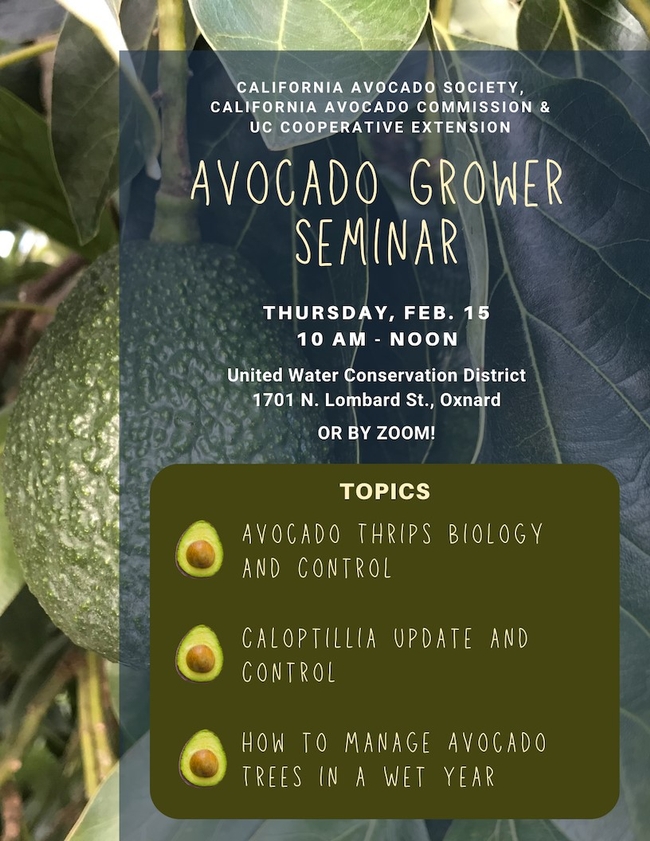
- Author: Ben Faber
Avocado Irrigation Workshop
August 10 (Thursday), 2023
1:00 – 4:00 P.M.
San Diego Farm Bureau
420 S Broadway, Escondido, CA 92025
Workshop registration link:
https://surveys.ucanr.edu/survey.cfm?surveynumber=40798
1:00 - 3:30 p.m. Agenda
1:00 Welcome
1:05 Challenges Due to Climate Change and Tools and Resources to Manage Risks - Dr. Tapan
Pathak, CE Specialist in Climate Adaptation in Agriculture, University of California, Merced
1:35 Interpreting Your Water and Soil Analysis Reports to Manage Your Avocado Grove – Dr.
Ben Faber, UCCE Subtropical Crops Advisor, Ventura and Santa Barbara Counties
2:05 Cost-effective Irrigation Tools for Efficient Water Management of California Avocados – Dr.
Ali Montazar, UCCE Irrigation and Water Management Advisor, San Diego, Imperial, and
Riverside Counties
2:35 Considerations about the Use of Plant-Based Sensors for Avocado Irrigation Scheduling –
Dr. Jochen Schenk, Professor of Department of Biological Science, California State University,
Fullerton
3:05 Development and Evaluation of Pathogen and Salinity Resistant Avocado Rootstocks – Dr.
Patricia Manosalva, Professor of Plant Pathology and Microbiology Department, University of
California, Riverside
3:35 RCD of Greater San Diego County Irrigation Management Programs and Projects – Joel
Kramer, Resource Conservation District of Greater San Diego County, Lakeside
4:00 ADJOURN
For more information about the workshop, please contact Ali Montazar, amontazar@ucanr.edu.
PENDING CEU CREDITS: CCA (3.0 hrs.)
SDRILG (3.0 hrs.)
